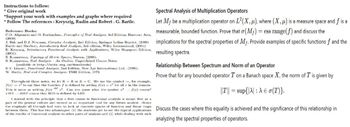
Algebra & Trigonometry with Analytic Geometry
13th Edition
ISBN: 9781133382119
Author: Swokowski
Publisher: Cengage
expand_more
expand_more
format_list_bulleted
Question

Transcribed Image Text:Instructions to follow:
* Give original work
*Support your work with examples and graphs where required
* Follow The references: Kreyszig, Rudin and Robert. G. Bartle.
Reference Books:
C.D. Aliprantis and O. Burkinshaw, Principles of Real Analysis, 3rd Edition, Harcourt Asia,
(2000)
J. Bak and D.J. Newman, Complex Analysis, 2nd Edition, Springer Indian Reprint, (2009)
Bartle and Sherbert, Introductory Real Analysis, 3rd edition, Wiley International, (2001)
E. Kreyszig, Introductory Functional Analysis with Applications, Wiley Singapore Edition,
(2001).
S. Kumaresan, Topology of Metric Spaces, Narosa, (2005).
S. Kumaresun, Real Analysis - An Outline, Unpublished Course Notes
(available at http://atts.org.in/downloads)
B.V. Limaye, Functional Analysis, 2nd Edition, New Age International Ltd., (1996).
W. Rudin, Real and Complex Analysis, TMH Edition, 1973.
f(x)
Throughout these notes, we let KR or K = C. We use the symbol, for example,
to say that the function f is defined by setting f(x)=2 for all z in the domain.
This is same as writing f(x) 2. Can you guess what the symbol 2
LIIS RIIS means that RIIS is defined by LIIS.
f(x) means?
I started with the principle that a first course in functional analysis is meant first as a
part of the general culture and second as an important tool for any future analyst. Ilence
the emphasis all through had been to look at concrete spaces of function and linear maps
Spectral Analysis of Multiplication Operators
Let My be a multiplication operator on L2(X,14), where (X,4) is a measure space and f is a
measurable, bounded function. Prove that σ (M+) = ess range(f) and discuss the
implications for the spectral properties of My. Provide examples of specific functions f and the
resulting spectra.
Relationship Between Spectrum and Norm of an Operator
Prove that for any bounded operator T on a Banach space X, the norm of T is given by
||T|| = sup{|A| : A € σ(T)}.
between them. This has two advantages: (1) the students get to see the typical applications Discuss the cases where this equality is achieved and the significance of this relationship in
of the results of functional analysis to other parts of analysis and (2) while dealing with such
analyzing the spectral properties of operators.
Expert Solution
This question has been solved!
Explore an expertly crafted, step-by-step solution for a thorough understanding of key concepts.
Step by stepSolved in 2 steps with 5 images

Knowledge Booster
Recommended textbooks for you
- Algebra & Trigonometry with Analytic GeometryAlgebraISBN:9781133382119Author:SwokowskiPublisher:Cengage
 Big Ideas Math A Bridge To Success Algebra 1: Stu...AlgebraISBN:9781680331141Author:HOUGHTON MIFFLIN HARCOURTPublisher:Houghton Mifflin Harcourt
Big Ideas Math A Bridge To Success Algebra 1: Stu...AlgebraISBN:9781680331141Author:HOUGHTON MIFFLIN HARCOURTPublisher:Houghton Mifflin Harcourt

Algebra & Trigonometry with Analytic Geometry
Algebra
ISBN:9781133382119
Author:Swokowski
Publisher:Cengage

Big Ideas Math A Bridge To Success Algebra 1: Stu...
Algebra
ISBN:9781680331141
Author:HOUGHTON MIFFLIN HARCOURT
Publisher:Houghton Mifflin Harcourt